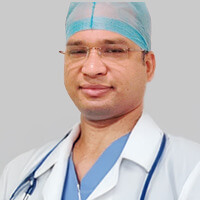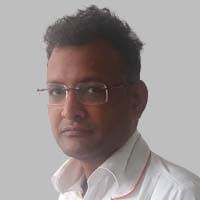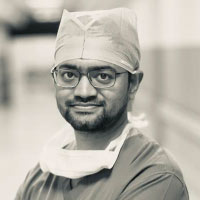Why is Partial Hip Replacement Surgery Required?
Partial hip replacement surgery is recommended by the orthopedist depending upon the extent of damage occurred to hip joint. It is generally performed if fracture that occurs in femoral neck cannot be fixed and socket remains intact or undamaged. Doctor needs to replace only the ball of the hip joint.
Let us understand grading of fractured neck of femur to understand the degree of damage done to the hip joint and accordingly, why partial hip replacement surgery becomes a necessary option.
- Type 1: Bones are pressed together and not disconnected. Also, their alignment is not affected in great extent. It's a kind of stable fracture.
- Type 2: Here, fracture of the bones occurs but alignment of the hip bones is still the same as it was before fracture.
- Type 3: Advanced stage of fracture where the bones are completely displaced but still there is a little contact between two bone fragments.
- Type 4: The last grading or stage of femoral neck fracture. In this phase, the bones are completely displaced and there is no contact between bone fragments.
Type 1, type 2 and type 3 kind of femoral neck fractures can be healed with help of nailing devices or pins. In type 4 fracture, the fragmented bone parts cannot be aligned or healed using any of the pins or nailing devices and also, blood supply to femoral head may disrupt that could lead to early bone death. Hence, to avoid such situations, orthopedist recommends partial hip replacement surgery. The acetabulum or the socket is not at all involved in partial knee replacement surgery since it's intact and healthy. Partial hip replacement surgery is a treatment for broken or fractured hips. It is not a treatment approach for patients suffering with degenerative arthritis in hip joint.
Pre-operative Preparation
In pre-operative preparation phase, doctor will tell you about some precautionary measures that you need to practice before undergoing partial hip replacement surgery.
- Inform your doctor about the medications that you are currently intaking. Also, let your doctor know about your past medical history. Doctor may discontinue blood thinning medications like aspirin and warfarin and other drugs. Medications which affect immunity power like Enbrel and methotrexate may also be discontinued by your doctor.
- Let the doctor know if you are a diabetic patient or if you are an expecting mother or if you are a cardiac patient.
- You need to quit the habit of smoking before you get ready for partial hip replacement surgery. Smoking not only delays recovery process but also is hazardous for your overall well-being. Alcohol consumption should also be limited or better if you don't consume alcohol at all prior to the surgery.
- Let the doctor know if you have cold or flu. Doctor may postpone your operation if the condition is worse.
Day Before Surgery:
Day before the surgery, vitals or important health parameters of the patient like blood pressure, body temperature, heart rate, etc. are checked and verified if these things are in normal range. Blood test may also be conducted to check for infection. It is better that you make arrangements for blood transfusions in case emergency arises. You may be admitted to the hospital the day before the surgery whenever your doctor suggests.
Procedure Day
On the day of partial hip arthroplasty, patient is advised to implement following precautions:
- Patient is advised to not consume, eat or drink anything for at least 6 hours prior to the surgery. Your surgeon will let you the know how long you got to fast.
- Again, before the surgery commences, your pulse rate, body temperature and blood pressure will be checked.
Methods/Techniques of Partial Hip Replacement Surgery
Partial hip replacement surgery is a quite a complex process and takes approximately an hour or two to complete. The ball present in hip joint will be replaced with prosthetic or man-made implants. The following is the surgical procedure of partial hip arthroplasty and takes place in following order:

- Anesthesiologist will first inject general anesthesia to make you unconscious during the surgical procedure.
- An incision is made either on the front part, side or at the back portion to access hip joint. Muscles, tissues, tendons are moved away in order to reach hip joint - femoral head which is the ball of the hip joint and acetabulum which is the socket. The hip is then placed in such a position so that the surgeon is able to open up the joint easily.
- Then, the femoral head is removed.
- To prepare for femoral stem insertion, channel inside the femur is hollowed out.
- The femoral stem is then secured into hollow portion of femur with the help of cement. Once it gets fixed, prosthetic implant (metal ball or ceramic ball) is then fixed to top of femoral stem.
- Hip joint is then rejoined and all the muscles and tendons that have previously been moved away in order to access hip joint, will now be placed back in their position and the procedure will get over.
Partial hip replacement techniques are getting better and implementation of less invasive partial hip replacement surgery has produced mix outcomes. Hence, the traditional way is still being practiced.
Post Procedure
Recovery time post partial hip replacement varies from patient to patient. It depends on how well you have followed your doctors instructions to take care of the operated hip joint post surgery.
Follow-up
Follow-up appointments with doctor should be periodical and strictly adhered to. These appointments update both patient as well as doctor about the outcome of partial hip replacement surgery and also detect any faults that might have occurred during surgery. As per your recovery, doctor will give you medications that you have to take on time.
Medications
In the initial few days, your hip movement will be restricted. Also, you will not find it comfortable to move around freely because of pain in the operated hip joint. It is normal that patient will experience pain and discomfort post partial knee replacement. But, to take care of the pain, doctor will prescribe some antibiotics and the medical staff will ensure that you experience less discomfort as possible.
Physiotherapy
You can also hire a physiotherapist to help you with exercises that will help in healing and restoring operated hip joint. Walking for few minutes post surgery with help of walking aids will help in strengthening of hip muscles. Eventually, you can switch over to low impact exercises like swimming.
Diet
Diet also plays vital role in recovery of the patient. Since you have undergone intensive surgery, you need to put your health on first priority. Firstly, you got to watch what you put in your mouth. Eat foods that are rich in iron, calcium and phosphorus.
Iron helps in increasing your blood count while calcium and phosphorus make your bongs strong. Iron that is obtained from plants, e.g. dates, raisins, spinach, kale, etc. is called non-heme-iron which is a little difficult for our body to absorb. But, the iron that is obtained from animal sources, e.g beef, chicken, liver etc. (heme iron) is easily absorbed by the body. Hence, if you are a vegetarian, you need to consume some source of vitamin C food so that iron is well absorbed.
Good sources of calcium and phosphorus are milk and dairy products, sardines, salmon, leafy vegetables, tofu, broccoli, bok choy, nuts, seeds, etc. Healthy diet will help in quick recovery.
Also, it's important that you keep yourself hydrated by consuming adequate amount of water and fluids in form of coconut water, herbs infused water, soups,etc. Smoking and alcohol consumption should strictly be avoided for quicker recovery.
Patients who have undergone partial hip replacement surgery take 3-6 weeks to recover completely and return to normal routine. Since, each patient is unique, recovery period will differ. Consult with your orthopedist to get more tips on post procedure recovery after partial hip replacement.
Risks And Complications
Since, partial hip replacement surgical procedure is a complex one, it does have its own share of risks and complications. Below mentioned are few common risks and complications that are likely to happen post partial hip replacement surgery.
- Blood clots:
Chances of blood clots forming in veins of the leg cannot be ignored. It could be dangerous as a piece of clot might travel through your bloodstream to heart, liver or lungs making it fatal. Hence, to avoid the risks of blood clots, blood thinning medications like warfarin or aspirin
- Infection:
Chances of infection are high at the site of operation where incision had been made and in the tissues situated deeper near the hip joint. Since the surgery involves wear and tear of the tissues, infection may occur. Infection can become a matter of concern if it happens near prosthetic implants which will again need to be replaced. To keep infection at bay, doctors prescribe antibiotics.
- Dislocation:
Dislocation can occur if the newly placed prosthetic ball implants are dislodged if you take certain positions. Hence, doctors advise you not to bend after the surgery to keep the ball in place. One should avoid bending at 90 degrees angle at hip and also not let the leg cross the mid-line of the body. If the hip joint dislocates, doctor fits a brace to keep the joint intact and in place. But, if hip joint keeps on getting dislocated repeatedly, then surgery becomes necessary to stabilize the hip joint.
- Fracture:
Fractures can occur during the surgery. Small fractures can heel on their own, but bigger fractures have to be fixed using pins, wires or bone grafts.
- Change in the length of leg:
Your surgeon does take precautionary measures during surgery to keep the leg length of the operated hip same as the other leg. But, new ball prosthetic implant may leave the operated leg longer or shorter than the other one. Change in leg length may also be caused because of weak muscles surrounding the hip. To fix, leg length problem, doctors will advise you to do some exercises that stretch and strengthen operated hip muscles.
- Loosening of implant:
It is a very rare kind of complication that the newly inducted implant will loosen up after some period of time. It may also happen that the prosthetic implant may not be solidly fixed to the bone that will eventually loosen it up. Surgery is the only option to fix this kind of complication.
- Need for another partial hip replacement surgery:
If you are young and have undergone partial hip replacement surgery, then you may need another one after a certain period because the prosthetic implant may wear out eventually. However, now-a-days, prosthetic implants are made up of durable materials which eliminate the need of having another surgery.
To conclude, partial hip replacement surgery is beneficial to all those patients whose hip joint has not been severely damaged and the surgeon needs to only replace ball of the hip joint with prosthetic implant. The surgery does have its share of risks and complications. But, it is a blessing for people who have fracture in their hip. With this surgery, they are able to live normal lives as they used to do previously.
































































































































































































































































































































































